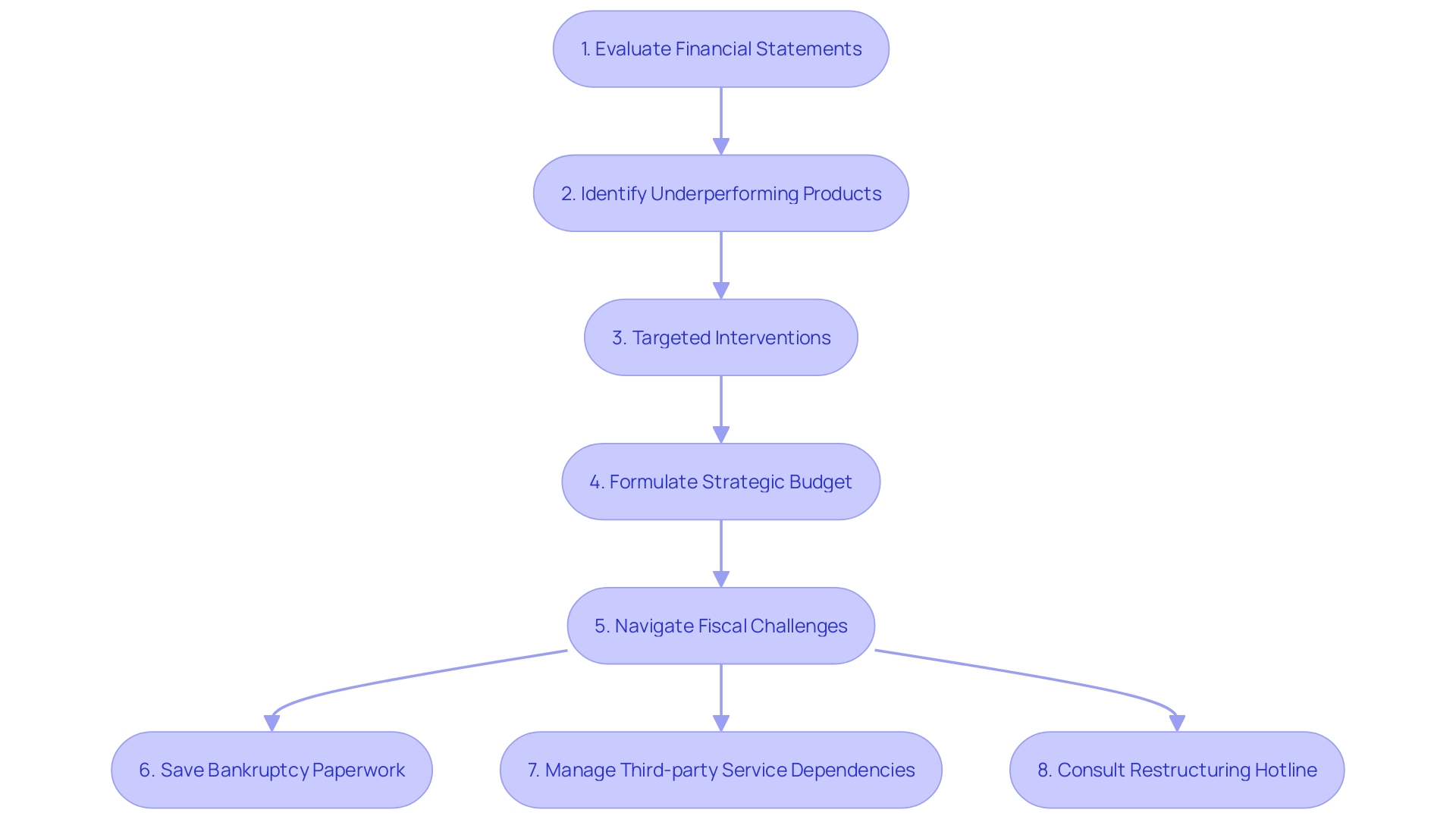Introduction
In the world of business and construction, the need for turnaround strategies is crucial when faced with challenges. These strategies involve a systematic approach to revitalizing entities and steering them towards positive outcomes. From leveraging prime locations to attract customers to implementing comprehensive financial restructuring plans, successful turnarounds require meticulous planning and execution.
This article explores key principles, stages of the turnaround process, case studies of successful turnarounds, financial restructuring and management, change management and leadership alignment, innovative approaches, and sustaining turnaround success. By delving into these topics, we can gain valuable insights into how to navigate the complexities of restructuring and achieve long-term viability and growth. So let's dive in and discover the strategies and solutions that can transform struggling businesses and construction projects into thriving enterprises.
Understanding the Need for Turnaround
Turnaround approaches are crucial for businesses and construction projects confronting challenges. These approaches encompass a systematic approach to revitalize and steer entities towards positive outcomes. A case in point is a branded hotel that struggled to boost Food & Beverage sales despite a prime location. A comprehensive turnaround strategy was developed, focusing on leveraging the hotel's location to attract diners. This multi-disciplinary approach included thorough research to select an apt restaurant concept, understanding client needs for consistent service, and optimizing restaurant layout to enhance seating and turnover rates. As a result, the hotel witnessed great reviews and a significant increase in sales within the first week.
The rigorous process of restructuring requires a clear timeline and actionable steps. It might involve considerations such as mergers or acquisitions, and meticulous planning to reach the desired end point within a set timeframe. Moreover, establishing a thorough Business Continuity Plan is essential for mitigating unforeseen setbacks, requiring an in-depth risk assessment to prepare for potential disruptions.
In the context of project management, we are reminded that if satisfaction with current construction industry performance is lacking, it's time to look beyond conventional methods. As mentioned in industry literature, project management has evolved through different eras to meet changing project needs. This evolution is a testament to the requirement of innovative approaches in project delivery and management.
Statistics from industry leaders such as Gilbane Inc. emphasize the significance of tools like the Architecture Billings Index (ABI) to anticipate trends and oversee construction processes efficiently. The ABI is a leading indicator of construction spending, assisting firms in budgeting and navigating economic fluctuations. Meanwhile, data from the Quarterly Census of Employment and Wages (QCEW) program show a decrease in labor market dynamism, emphasizing the need for strong turnaround approaches to address these trends.
In sum, the essence of turnaround lies not just in identifying problems but in executing a strategic plan that leads to a successful restructuring, ensuring long-term viability and growth.
Key Principles of Turnaround Strategies
Successful turnarounds are not accidental—they rely on carefully crafted plans supported by crucial principles. These principles encompass a meticulous examination of the present landscape, pinpointing and rectifying pivotal issues, establishing attainable targets, crafting an all-encompassing strategy, and implementing it with unwavering precision. The tale of WeWork's transformative reorganization, emerging from Chapter 11, embodies these principles. The company's proactive approach included eliminating over $4 billion in debt and renegotiating numerous leases, setting the stage for sustainable growth. This accomplishment was accomplished through the combined endeavors of a committed team and the backing of their members, reflecting the core of successful enterprise and construction transformation. Such transformations emphasize the need for preparation and the development of a strong continuity plan, principles that WeWork and other leading firms have utilized to navigate the complexities of today's market.
Through careful examination and a solid base established on reorganization, WeWork eradicated more than $4 billion in debt, showcasing the effectiveness of a well-implemented turnaround strategy. * A Plan of Reorganization was a decisive step in WeWork's journey, highlighting the importance of strategic planning in achieving profitable growth and service excellence. The company's restructuring efforts, guided by principles of preparation and comprehensive planning, provide a blueprint for sustainable success in the unpredictable corporate environment.

Stages of a Turnaround Process
The journey to revitalize a struggling business or to optimize an operational process in construction involves strategic, meticulous planning, and execution. Initially, it starts with a thorough assessment and diagnosis of the issues at hand. Experts in the field, such as John Young, recognize that understanding the industry is a crucial initial phase, as shown by a hotel's successful approach to enhance its food and beverage sales by capitalizing on its prime location.
Following the assessment, the development of a tailored turnaround plan is essential. This includes preparing detailed financial materials, product descriptions, and differentiation strategies, as emphasized by GrowthPoint during their Data Prep phase. Such preparation is not only crucial for internal clarity but also plays a vital role in addressing the queries of potential investors or acquirers.
Execution of the plan is where the rubber meets the road. In IBL's case, innovation was embedded in their culture, but the need for a balanced innovation portfolio became evident to focus on all categories of innovation, especially during challenging times marked by the pandemic and other external pressures.
Finally, the monitoring and evaluation phase is critical to ensure the turnaround is on track. WeWork's restructuring, driven by technology and flexible space offerings, highlights the importance of adapting to market demands. Their forward-looking statements on continuing operations as debtors-in-possession, with the expectation of reducing significant debt, underscore the ongoing transformation efforts that include revamping the existing model.
The ability to navigate through these stages effectively can lead to remarkable outcomes, such as considerable sales increases and excellent reviews in the initial weeks post-implementation. With over 600,000 startups worldwide and the constant need for innovation, companies must adapt every two to five years to remain competitive. Effective change management approaches can significantly enhance an organization's likelihood of achieving its strategic objectives, as they concentrate on preparing and supporting employees through change, which is vital in a intricate and constantly evolving work environment.

Case Study: Successful Turnaround Examples
Examining examples of prosperous business and construction turnarounds offers a plethora of insights into the methods and approaches that result in triumph over adversity. For instance, Pacific Steel & Recycling, a midsized company in Montana, achieved a significant reduction in their per-person health spending by adopting a transparent, data-driven approach. The company transitioned from traditional insurance networks to a model based on reference-based pricing, which aligns closely with Medicare rates. This approach, developed with the assistance of USI Insurance Services, led to more sustainable health care costs without sacrificing employee benefits.
In another example, a major branded hotel with a central location struggled to increase its food and beverage sales. The turnaround approach centered on capitalizing on its prime location to draw in more diners, highlighting the significance of comprehending the market to attain success. This multi-disciplinary approach resulted in excellent reviews and a notable increase in sales within the first week.
The restoration and reuse of old buildings is another area where turnaround efforts can have a substantial impact. The restoration not only preserves the character of these structures but also presents an opportunity for commercial revitalization, aligning with the IPCC's findings on the significant CO2 emissions reduction potential through refurbishment in developed countries.
The significance of a well-structured process to efficiently implement adjustments or pivots is emphasized by the complexity of mergers, acquisitions, or sales. Successful integration requires a thoughtful approach to planning, decision-making, and communication with both team members and customers.
The recent surge in unicorns—startups valued at over $1 billion—highlights the potential for rapid growth, but the true measure of success is the ability to generate cash from operations at scale without continual venture capital funding.
These examples emphasize the point that a well-thought-out and implemented turnaround plan can result in impressive results, benefiting not just the company but also its employees and the wider community.
Financial Restructuring and Management
At the core of any successful recovery lies a strong financial restructuring strategy. This approach encompasses a comprehensive evaluation of the company's financial status, with an emphasis on analyzing financial statements in detail. For instance, a sharp decline in revenue might be traced back to underperforming products, allowing for targeted interventions. Whether discontinuing those products or revitalizing their market appeal, the aim is to stabilize and bolster the financial health of the company. A strategic budget, informed by this analysis, is then formulated to navigate through fiscal challenges and ensure the business's return to stability.
The recent surge in corporate bankruptcies underscores the need for proactive financial reorganization. With bankruptcies peaking in Q2 of 2023, financial leaders are reminded of the volatility in markets ranging from retail to banking. Companies like Wilko have seen the stark reality of failing to adapt, leading to significant borrowing and job cuts before succumbing to administration. Such cases highlight the significance of a well-executed process that not only tackles immediate liquidity concerns but also establishes the foundation for sustainable long-term growth.
A case in point is TBC Bank, which has managed to pivot from large-scale operations to a model of continuous value delivery, epitomizing the essence of efficient financial transformation. By reorganizing financial obligations and revamping their financial framework, TBC Bank has enhanced its operational resilience, illustrating how strategic reorganization can serve as a lifeline for distressed companies.
To achieve this, it's crucial to identify and address the root causes of financial distress, which may include excessive debt, profitability issues, or liquidity constraints. The goal is to redefine the company's financial trajectory, aiming for debt reduction, improved cash flow, enhanced profitability, or an optimized capital structure. In the end, successful financial reorganization can not only prevent the dangers linked to financial instability but can also offer a clear path to recovery and growth.

Change Management and Leadership Alignment
Successfully navigating the intricacies of organizational change necessitates more than just a strategic vision; it requires a mastery of change management and the ability to unite leadership under a common goal. Effective communication, a motivated workforce, and a culture of accountability are pillars of this transformative process. As a case in point, Stora Enso, a centuries-old paper manufacturer, embraced these principles when it reshaped its identity into a renewable materials company. This pivot to sustainability and innovation was necessitated by evolving market trends and involved a significant overhaul that included a leadership change and workforce reduction. The experience of Stora Enso underscores the critical nature of managing the human aspects of organizational changes. The workforce often grapples with the anxiety and stress that accompany changes in job security, roles, and organizational culture. Acknowledging and addressing these emotional responses is vital for a smooth transition.
The occurrence of reorganization is not exclusive to Stora Enso; it is a reflection of the wider commercial environment where alteration is a constant assurance. Analyst Bryan Solis discovered that growth opportunities and market competition drive over half of enterprises to pursue modification. Furthermore, competitive pressures and the need to keep up with rapid technological advancements compel nearly 80% of organizations to adapt every two to five years. Organizational Change Management (OCM) offers a structured approach to this inevitability, involving strategic preparation, careful implementation, and diligent follow-through. OCM is instrumental in guiding an organization through significant change, mitigating the internal turmoil that can arise, and ensuring the transition maximizes the benefits while minimizing disruptions.
McKinsey's Global Survey on transformations illustrates the high stakes involved in managing change, with successful transformations requiring a comprehensive approach that combines will, skill, rigor, and scope. Importantly, specific actions have been identified that significantly increase the likelihood of both achieving sustained performance improvements and establishing a lasting competitive advantage. This insight is a clarion call for leadership to adopt a multifaceted approach that not only focuses on the technical aspects of restructuring but also prioritizes the well-being and adaptability of its most valuable asset—its people.

Innovative Approaches to Turnaround
The key to a successful transformation plan lies in the capacity to not only address present challenges but to envision the future of an organization. This requires a blend of ingenuity, technology, and a culture that champions continuous innovation. Take, for example, the transformative case of a hotel facing the challenge of underutilized space due to an inconvenient outdoor corridor. The solution was not found in the traditional playbook but rather through a series of 'What if?' questions that led to the internal relocation of the corridor and the conversion of suites into more marketable units. The result? A surge in sales and glowing reviews.
In embracing innovation, it is essential to leverage data analytics, automation, and other technological advancements to pinpoint opportunities and streamline processes. For instance, a hotel's strategic use of its central location to boost food and beverage sales, or the adoption of ground heat pumps to tackle emissions, demonstrate how strategy and innovation can align to drive growth and sustainability.
Moreover, the latest societal and demographic trends show a significant shift towards adaptive reuse projects, with a 25% increase in office-to-apartment conversions over a single year. This aligns with clients' desires for spaces that are environmentally responsible and enhance wellbeing.
Ultimately, innovation is about envisioning a future that surpasses the present and making strategic decisions that align with that vision. As posited by Isadore Sharp of Four Seasons, redefining luxury to better meet guest needs was not just a refinement but a significant leap forward. Likewise, enterprises must connect innovation endeavors to strategic priorities and distinctive advantages to generate transformative solutions that enhance the bottom line.

Sustaining Turnaround Success
Achieving a turnaround is just the beginning; the true challenge lies in maintaining that momentum for continued success. Strategies that have proven effective include diligent performance monitoring, ongoing improvement initiatives, and retaining key talent. Moreover, strategic planning is essential in transitioning from a state of crisis to a trajectory of growth. For example, a prominent hotel in a thriving city center utilized its prime location to enhance Food & Beverage sales, employing a multi-disciplinary strategy that included research and optimizing restaurant layout for increased turnover. This method not only met the immediate needs but set the stage for sustained performance. Additionally, it's important to be proactive, continually refining business processes even if they're currently effective. As Tim Creasey, Prosci's Chief Innovation Officer, asserts, the seeds of success are planted early, and leaders must activate sustainment from the onset of change management. Embedding changes into the organizational culture ensures they become standard operations, preventing a relapse into previous inefficiencies. This concept of sustainment in change management is crucial and cannot be overlooked, as premature shifts in focus can jeopardize long-term improvements. The impact of such strategic decisions can be seen in the construction industry where the initial design choices, such as flooring systems, have implications that last for decades and significantly affect operations and maintenance costs. Keeping an eye on the long-term lifecycle of assets is therefore essential. Leveraging industry data, such as the Architecture Billings Index, can provide insights into market movements and help in strategic decision-making. In summary, the path to enduring success after a turnaround involves a combination of strategic foresight, continuous optimization, and a deep understanding of the long-term implications of operational decisions.

Conclusion
In conclusion, successful turnarounds in business and construction require meticulous planning, execution, and a combination of strategies. Key principles like thorough examination of the present landscape and setting attainable targets underpin these strategies. Case studies, such as WeWork's transformative restructuring and Pacific Steel & Recycling's cost reduction, highlight the power of well-executed plans and preparation.
The stages of a turnaround involve assessing issues, developing a tailored plan, and executing and monitoring it. Change management and leadership alignment are crucial for navigating complexities, with effective communication and accountability.
Financial restructuring is vital for recovery, involving evaluating financial status and formulating a strategic budget. Successful restructuring averts risks and paves the way for growth.
Innovation is essential, leveraging technology, data analytics, and societal trends. Embracing ingenuity and a culture of continuous innovation leads to transformative solutions.
Sustaining success requires ongoing monitoring, improvement initiatives, and retaining key talent. Strategic planning and embedding changes into the organizational culture ensure long-term improvements.
In summary, successful turnarounds require meticulous planning, execution, and a combination of strategies. By leveraging prime locations, implementing financial restructuring, embracing innovation, and sustaining momentum, struggling businesses and construction projects can achieve long-term viability and growth.




